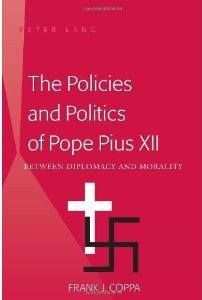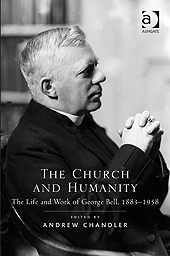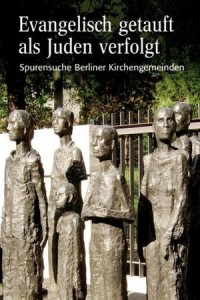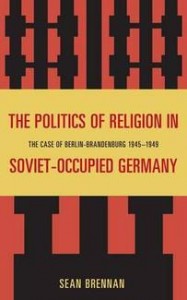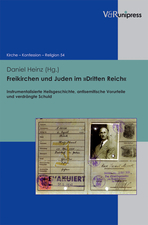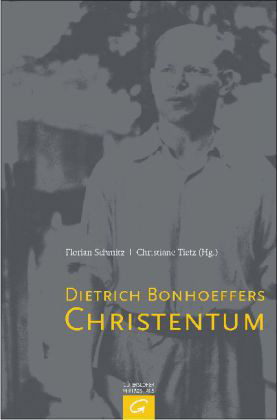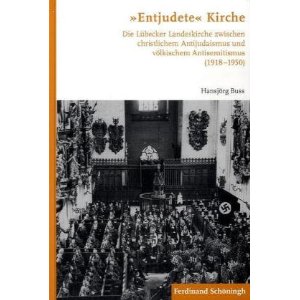Contemporary Church History Quarterly
Volume 19, Number 2 (June 2013)
Review of Wilhelm Damberg, ed., Soziale Strukturen und Semantiken des Religiösen im Wandel (Essen: Klartext, 2011), 224 Pp.
Originally reviewed for H-Net: Humanities and Social Sciences Online (H-German).
By Lauren N. Faulkner, University of Notre Dame
Religious Transformations in the Post-War World
In 2003, an interdisciplinary group of historians, theologians, sociologists, and educators in religious studies met at Bochum University, one of Germany’s pre-eminent research institutions, to commence an ambitious study of religious processes of transformation. In addition to religion, their specific focus was die Moderne, usually translated as “the modern” and, insofar as its definition is concerned, much open to debate in any language. With the support of the Deutsche Forschungsgemeinschaft (DFG), this collection of essays, Soziale Strukturen und Semantiken des Religiösen im Wandel, edited by Wilhelm Damberg (Essen, 2011) is deliberately presented as an interim account [Zwischenbilanz] focused on the German republic. The larger research project is meant to produce several more volumes in the coming years, moving beyond the current volume’s chronological framework (1949-1989) as well as embracing transnational perspectives.
Damberg, a professor of church history at Bochum, edited the volume with the aid of Frank Bösch, Lucian Hölscher (who provides the final essay on secularization), Traugott Jähnichen, Volkhard Krech, and Klaus Tenfelde, who passed away shortly after its publication. Damberg is the author of the very detailed introduction, in which he both sketches the broad contours of the Bochum group’s project and offers useful overviews of the essays and their place within the larger context of the project. In pursing an investigation of the transformation of religion in Germany after the Second World War, several themes run concurrently through the essays: the sociology of religion, including analyses of the processes of secularization, democratization and privatization; the emergence of “new histories” and their attention to religion (as opposed to older histories, particularly of West Germany, which treated religion as a separate, unintegrated chapter); and theological developments, innovations, and controversies, including the impact of Vatican II and the attempts of the Protestant churches to come to terms with the recent German past.
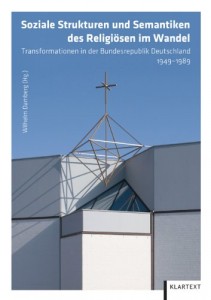 Many of the authors offer inter-denominational (that is, Protestant and Catholic) comparison, with an emphasis on the rise and influence of mass media, and the nature of the discourse about the role of religion and spirituality in the daily lives of individuals, including its participants and changes over time. These reflect the ambitions of the larger Bochum project: to produce a detailed examination of the religious sphere and its gradual change over the years and decades since the last world war, and to evaluate the multiple influences of geography, gender dynamics, political contexts, economic realities, and the fluctuating strengths and weaknesses of ecclesiastical and non-ecclesiastical institutions. Above all, the project highlights the interdependence of the social and the cultural worlds, which are treated as concurrent, overlapping spheres rather than distinct entities. The processes and influences under consideration are situated in a six-point matrix that has a vertical dimension, divided into macro-, meso- and micro-levels, and two broad sociological dimensions, semantics and social structures (a helpful diagram is provided on 23).
Many of the authors offer inter-denominational (that is, Protestant and Catholic) comparison, with an emphasis on the rise and influence of mass media, and the nature of the discourse about the role of religion and spirituality in the daily lives of individuals, including its participants and changes over time. These reflect the ambitions of the larger Bochum project: to produce a detailed examination of the religious sphere and its gradual change over the years and decades since the last world war, and to evaluate the multiple influences of geography, gender dynamics, political contexts, economic realities, and the fluctuating strengths and weaknesses of ecclesiastical and non-ecclesiastical institutions. Above all, the project highlights the interdependence of the social and the cultural worlds, which are treated as concurrent, overlapping spheres rather than distinct entities. The processes and influences under consideration are situated in a six-point matrix that has a vertical dimension, divided into macro-, meso- and micro-levels, and two broad sociological dimensions, semantics and social structures (a helpful diagram is provided on 23).
The essays themselves can be grouped into three distinct categories. In the first, devoted to religious socialization, Dimitrej Owetschkin takes on the changing role of priests, pastors, and the “priestly image.” Markus Hero examines the evolution of alternative religious forms, including non-institutional spiritual movements of the private, popular, and individual natures. Although Owetschkin and Hero are focusing on very different actors – one the lower clergy of institutional churches, the other new and unprecedented spiritual figures who had nothing to do with these churches – both locate the 1960s as an important nexus of the necessary transformative processes. Social engagement and criticism, a growing sense of “world responsibility”, the need for the churches to become more expansive and horizontal, and less vertical (concentrated on hierarchy and authority), the drop in the number of regular church-goers, and the growth of the service industry are a few of the several factors that Owetschkin and Hero cite in their analyses.
The second category deals with changes in the “business” of religion. Andreas Henkelmann and Katharina Kunter’s article examines the breaks with tradition in the fields of charity work and social welfare. Uwe Kaminsky and Henkelmann continue the study of social welfare trends in looking at the evolution of psychological counseling, and the emergence of church-run counselor services in the 1950s as a new kind of charity. Rosel Oehmen-Vieregge investigates the development of women’s synods across (Western) Europe from the 1970s on. Sebastian Tripp’s article confronts the challenge of globalization to the institutional churches, the impact of decolonization on church missions, and changing perceptions of the Third World. Initiatives and pressures external to church leadership play a key role in each article. For Kunter, Kaminsky, and Henkelmann (who co-authored both pieces on welfare and charity), church-run organizations and clergy remained intrinsic to these kinds of operations, but demands for professionalization and the availability of new kinds of education, particularly in the discipline of psychology, meant increased involvement of lay professionals, including women. Oehmen-Vieregge underscores the role that women played in becoming more active in church life via the formation of various women’s synods from the 1970s to the first decade of the twenty-first century, and Tripp follows with an analysis of the new initiatives and kinds of legitimacy that emerged among Third-World groups and missions after the disintegration of the colonial world. None of these articles goes so far as to suggest that traditional church leadership was overtly challenged, but all point to various new agents who had little to no relationship with church leaders, who gained mounting influence in operations that for decades had been under the prerogative of the churches.
The final category considers religion in the age of mass media and “the public” [die Öffentlichkeit]. Sven-Daniel Gettys discusses changes in church policy regarding journalism and information sharing. Thomas Mittmann examines the ways in which the traditional churches attempted to maintain their social influence while simultaneously acknowledging the need for increased democratization through the use of popular events and the introduction of new liturgies and worship services. Nicolai Hannig studies the role of the media in shaping religious beliefs in an age of rapidly-developing media technology. Benjamin Städter’s article a good complement to Hannig’s, focusing on the production of visual images of Vatican II and their proliferation and impact. Whereas Gettys and Mittman are interested in exploring the self-perception of the institutional churches by looking at hierarchical attitudes towards different forms of media, journalism, and church congresses, Hannig and Städter focus on the types of media that have tried to make the churches and religion more accessible, via documentaries, opinion polls, and the magazine Stern’s public survey about religion in 1965, and via the publication and dispersal of photographs of popes, the church hierarchy, and the opening of Vatican II.
Lucian Hölscher’s article serves as a conclusion to the volume, examining various understandings of the slippery term “secularization” during the long 1960s. Hölscher’s investigation of the idea of secularization provides a terminological reflection on a word that appears in most of the essays in the volume, introducing the reader to a brief history of the term and suggesting that, if we accept that “secularization” is one of the twentieth century’s central concepts, more study must be conducted on the relationship between state and society in view of the religious sphere (and not merely on the social aspects of religion and the churches).
Readers should be aware of what the book is not: it is not a series of essays about people themselves who effected change. This volume deals with concepts – the transformation of semantics and structures, as the title indicates – rather than individuals. The authors are focused on processes and shifts over time in beliefs, attitudes, and modes of expression about religion and faith. There are very few named individuals, and none at all who serve as the explicit subject or focus of a study. The result is a volume that is oddly bereft of people, despite its interest in the ways people individually (the micro-level, as stipulated in the introduction) and collectively (the meso- and macro-levels) experience and communicate about religion.
The book’s self-proclaimed aim, to study religious transformation in the modern era, means that its subject is large, ambitious, and not uncontroversial. And admittedly, there are some gaps. Damberg concedes in the introduction that the absence of East Germany in this study is notable, though he points to separate studies that are in the works. Yet the volume’s attention to comparison, and the willingness of some of the essays to discuss the post-1990 period, leaves the reader thirsting for an idea of what was going on with East Germans and how they contributed to the post-1990 happenings. With few exceptions – Oehmen-Vieregge mentions the participation of Muslim women in some women’s gatherings; Hero discusses non-traditional spiritual figures, including gurus, shamans, and astrologers – the “religious sphere” is confined to and defined by the Christian religions, leaving one impatient for the volumes (which are forthcoming) dealing with non-Christian ones, particularly the impact of Muslims and Jews in Germany in the last third of the twentieth century.
One may also criticize the book for being jargon-heavy, though the authors do provide definitions and explanations, sometimes quite detailed, especially if the word is controversial, of most of the terms in use (Eventisierung, featured prominently in Mittmann’s article, may be the only concept that has no ready English equivalent). In fact, this exercise in probing definitions is one of the book’s true strengths, since it invites the reader to rethink and challenge longstanding assumptions about different aspects of religious change in the twentieth century. In selecting “transformation” as the leitmotif of the book, normative concepts are destabilized, poked and prodded, and interrogated in innovative and enlightening ways. While the definition of words like modernization and secularization remain variable, their meaning and impact on events and people, from psychologists and journalists to parish priests and pastors, is made clearer. Other terms, including liberalization, democratization, and pluralization, are given added coherence as individual articles demonstrate how they emerged to become important vehicles of change over time.
The book is also a successful example of distinctive approaches to the same subject: it is a solid showcase for effective interdisciplinary research and writing. The various methodologies emphasize the different research fields and specialties of the authors, who hold degrees in sociology, history, theology, philosophy, economics, and political philosophy. A list of publications of these authors is included at the back; perhaps in future volumes, a list of short author biographies will also be included (biographies of authors for this book are found easily online, on the DFG-Forschergruppe website dedicated to the Bochum Project). Because of the different questions, agendas, and research tools on display in these articles, they yield a multi-faceted, detailed, broad-reaching book that stays true to its core mission: underscoring the displacement, alteration, and relocation of church infrastructure in West Germany between 1949 and 1989, and the instabilities in and changes to religious meaning and interpretation. Moreover, the authors do not attempt to offer the final word on any of the subjects under consideration; this is the opening of a discussion rather than its conclusion. If this book sets the standard for the Bochum Project’s coming volumes, which the editor insists will expand beyond the borders of West Germany and Europe, and beyond the four-decade timeframe featured here, then a significant new series is in the making, and anyone with an interest in the relationship between society and religion needs to take notice.

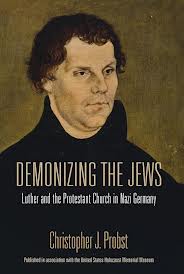 Christopher Probst has written an insightful analysis of the ways in which Protestant reformer Martin Luther’s anti-Jewish writings were used by German Protestants during the Third Reich. Fundamental to Probst’s work is his consistent use of Gavin Langmuir’s distinction between non-rational anti-Judaism (antipathy rooted in theological differences or other symbolic language which stand apart from and not against rational thought) and irrational antisemitism (antagonism rooted in factually untrue and slanderous accusations against Jews). In contrast to the idea that pre-modern anti-Jewish thought was generally religious and therefore anti-Judaic while modern anti-Jewish thought is political or racial and therefore antisemitic, Probst sees both anti-Judaic and antisemitic elements in the language of Luther and the twentieth-century German theologians, church leaders, and pastors who invoked him (3-4, 6, 17-19). In light of this, Demonizing the Jews is a book about historical continuity.
Christopher Probst has written an insightful analysis of the ways in which Protestant reformer Martin Luther’s anti-Jewish writings were used by German Protestants during the Third Reich. Fundamental to Probst’s work is his consistent use of Gavin Langmuir’s distinction between non-rational anti-Judaism (antipathy rooted in theological differences or other symbolic language which stand apart from and not against rational thought) and irrational antisemitism (antagonism rooted in factually untrue and slanderous accusations against Jews). In contrast to the idea that pre-modern anti-Jewish thought was generally religious and therefore anti-Judaic while modern anti-Jewish thought is political or racial and therefore antisemitic, Probst sees both anti-Judaic and antisemitic elements in the language of Luther and the twentieth-century German theologians, church leaders, and pastors who invoked him (3-4, 6, 17-19). In light of this, Demonizing the Jews is a book about historical continuity.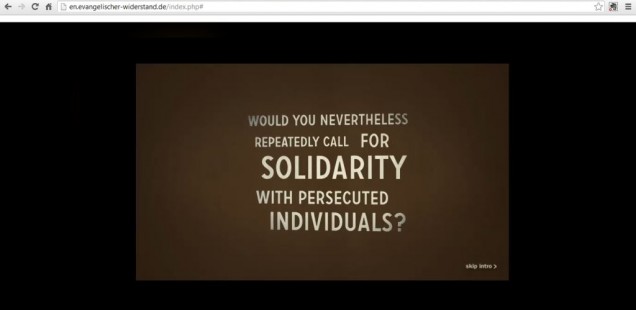 The interactive website “Evangelischer Widerstand” (
The interactive website “Evangelischer Widerstand” (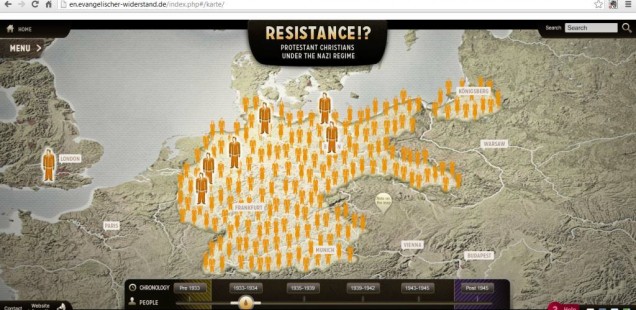 This is the website developed over the past couple of years by the Evangelische Arbeitsgemeinschaft für Kirchliche Zeitgeschichte (Protestant Working Group for Contemporary Church History) in Munich, under the leadership of Dr. Claudia Lepp, along with Drs. Siegfried Hermle, Harry Oelke, and a host of other notable German scholars. It is sponsored by the Evangelical Church in Germany, the Evangelical Lutheran Church in Bavaria, the Protestant Church in Hesse and Nassau, and the Köber Foundation of Hamburg, and supported by a long list of academics, Protestant notables, archives, memorial sites, and other institutions. It contains information on no less than three dozen (as of March 2013) individual or group resisters, along with a timeline, a series of fundamental questions, photos, documents and audio clips. It is a rich and growing set of resources, tied to a substantial bibliography of German-language publications on the topics of resistance and the German churches under Hitler. (Hopefully, over time, the bibliography will grow to include many of the important English-language studies on the German churches in the Nazi era.)
This is the website developed over the past couple of years by the Evangelische Arbeitsgemeinschaft für Kirchliche Zeitgeschichte (Protestant Working Group for Contemporary Church History) in Munich, under the leadership of Dr. Claudia Lepp, along with Drs. Siegfried Hermle, Harry Oelke, and a host of other notable German scholars. It is sponsored by the Evangelical Church in Germany, the Evangelical Lutheran Church in Bavaria, the Protestant Church in Hesse and Nassau, and the Köber Foundation of Hamburg, and supported by a long list of academics, Protestant notables, archives, memorial sites, and other institutions. It contains information on no less than three dozen (as of March 2013) individual or group resisters, along with a timeline, a series of fundamental questions, photos, documents and audio clips. It is a rich and growing set of resources, tied to a substantial bibliography of German-language publications on the topics of resistance and the German churches under Hitler. (Hopefully, over time, the bibliography will grow to include many of the important English-language studies on the German churches in the Nazi era.)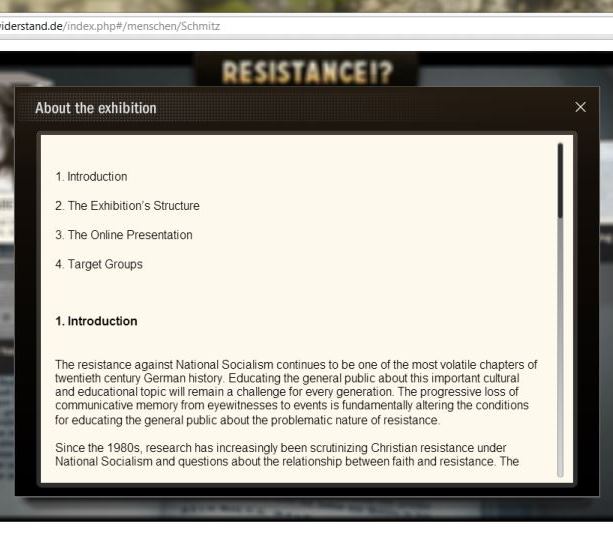 In the “About the exhibition” section of the site, Claudia Lepp and her colleagues explain their historical assumptions and methodology. They argue that the resistance against National Socialism “continues to be one of the most volatile chapters of twentieth century German history,” express their concern about “the progressive loss of communicative memory from eyewitnesses to events,” and note “the problematic nature of resistance.” Delving into the historiography of the German churches under Nazism, they identify a shift during the 1980s away from a focus on the Confessing Church and towards four new issues: 1) the role of resistance in the everyday life of Christian congregations and the question of who was motivated by their Christian faith to aid the victims of persecution; 2) the significance of “less noted” groups like the Religious Socialists, liberal Christians, Christians in the National Committee for Free Germany, conscientious objectors and those who deserted on account of their Christian faith; 3) the personal faith of resistance members and its relationship to their ethical and political thinking; and 4) the proper historical presentation of resistance “detached from forms of heroization.”
In the “About the exhibition” section of the site, Claudia Lepp and her colleagues explain their historical assumptions and methodology. They argue that the resistance against National Socialism “continues to be one of the most volatile chapters of twentieth century German history,” express their concern about “the progressive loss of communicative memory from eyewitnesses to events,” and note “the problematic nature of resistance.” Delving into the historiography of the German churches under Nazism, they identify a shift during the 1980s away from a focus on the Confessing Church and towards four new issues: 1) the role of resistance in the everyday life of Christian congregations and the question of who was motivated by their Christian faith to aid the victims of persecution; 2) the significance of “less noted” groups like the Religious Socialists, liberal Christians, Christians in the National Committee for Free Germany, conscientious objectors and those who deserted on account of their Christian faith; 3) the personal faith of resistance members and its relationship to their ethical and political thinking; and 4) the proper historical presentation of resistance “detached from forms of heroization.”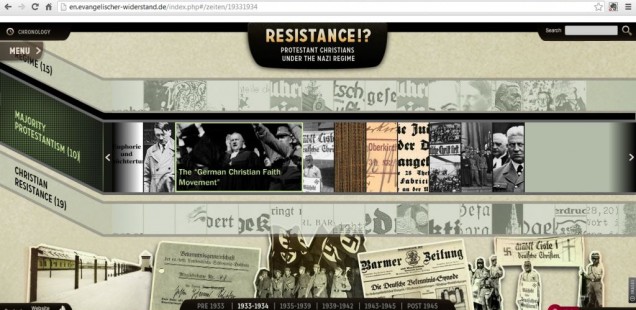 A similar analysis could be made of the timeline. Here the web historians offer up three streams of articles—on the “Regime,” on “Majority Protestantism,” and on “Christian Resistance.” There are entries about Hitler’s misleading pro-Christian statements, the German Christian Faith Movement, and other aspects of the history of Protestant collaboration with the Hitler state. Still, in the crucial 1933-1934 section, the 19 articles devoted to aspects of Christian Resistance are almost double the 10 entries given over to the compromised majority Protestants, once more creating the impression that Christian Resistance was, in fact, the most obvious Christian response to the Nazi dictatorship.
A similar analysis could be made of the timeline. Here the web historians offer up three streams of articles—on the “Regime,” on “Majority Protestantism,” and on “Christian Resistance.” There are entries about Hitler’s misleading pro-Christian statements, the German Christian Faith Movement, and other aspects of the history of Protestant collaboration with the Hitler state. Still, in the crucial 1933-1934 section, the 19 articles devoted to aspects of Christian Resistance are almost double the 10 entries given over to the compromised majority Protestants, once more creating the impression that Christian Resistance was, in fact, the most obvious Christian response to the Nazi dictatorship.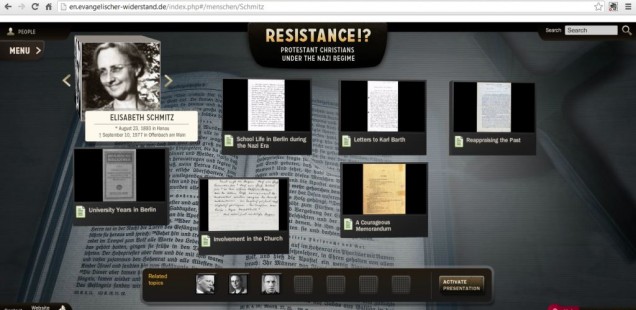 Because of these two weaknesses in the website’s approach to presenting the history of the German churches in the Third Reich, “Evangelischer Widerstand” works best when it tells the stories of the heroic, deeply-principled Christians who acted decisively against the regime and its policies. Elisabeth Schmitz is a good example. Just as Manfred Gailus has recently argued in his fine history
Because of these two weaknesses in the website’s approach to presenting the history of the German churches in the Third Reich, “Evangelischer Widerstand” works best when it tells the stories of the heroic, deeply-principled Christians who acted decisively against the regime and its policies. Elisabeth Schmitz is a good example. Just as Manfred Gailus has recently argued in his fine history 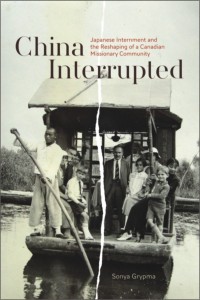 It is surely regrettable that the considerable contributions made by the Canadian churches to the early twentieth century missionary endeavours are now largely forgotten, or in some cases deplored as an example of “imperialist cultural aggression.” In fact, a hundred years ago, in proportion to their size and resources, the churches of Canada sponsored more missionaries at home and abroad than any other nation. The young men and women who volunteered their services were responding to the popular call for “the evangelization of the world in this generation.” China was the preferred destination, and indeed became the flagship of European and North American missionary expansionism.
It is surely regrettable that the considerable contributions made by the Canadian churches to the early twentieth century missionary endeavours are now largely forgotten, or in some cases deplored as an example of “imperialist cultural aggression.” In fact, a hundred years ago, in proportion to their size and resources, the churches of Canada sponsored more missionaries at home and abroad than any other nation. The young men and women who volunteered their services were responding to the popular call for “the evangelization of the world in this generation.” China was the preferred destination, and indeed became the flagship of European and North American missionary expansionism.